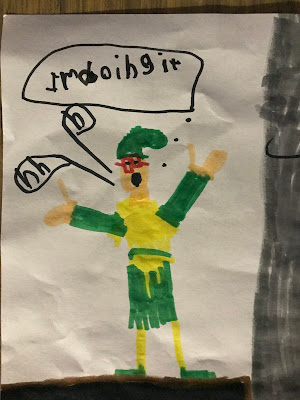This year, we've been studying a variety of things including how to read a chapter book, the Middle Ages, the Renaissance, inventions, the human body, the heart, emotional regulation (Zones of Regulation), and even Shakespeare, just to name a few.
So many of these things came together this past week in an exciting, educational way. So fun!
In Heart Matters Part 1 we learned:
1. about a heart surgeon's job
2. how the circulatory and the respiratory systems work together
3. the amygdala monster really does makes our heart rate and our breathing increase
4. that mindfulness works. We now have proof!
Here is the continuation of this list:
5. We've been collecting "tools" for calming our bodies/slowing our heartrates in a variety of situations.

This is a tool from the Zones of Regulation curriculum a student can use in a variety of situations.
6. We read Stage Fright on a Summer Night, a Magic Tree House story where Jack and Annie go back in time and help William Shakespeare with his play. As they play the role of fairies in A Midsummer Night's Dream, Jack experiences extreme stage fright.
Such a great way to introduce Shakespeare and to include him in our study of the Renaissance!
We talk and draw about ways to handle stage fright, including saying positive things to ourselves. This "tool" will come in handy for our upcoming talent show in a few weeks.
Jack has "flipped his lid!" This is Jack with his amygdala monster going haywire. He needs to get his "thinking brain" working again.
This is Jack realizing that he has exaggerated and it's not as bad as he thinks it is. There are 3000 people in the audience, not 1 million! Also notice his hexagon and infinity sign breathing in the upper left hand corner.
This is Jack taking deep breaths. Annie is cheering him on. It's always good to have a friend.
7. We read and watched several versions of A Midsummer Night's Dream including this video and several books from this series.
8. Shakespeare "invented" over 1700 English words including bedazzled, hot-blooded, dishearten, eventful, eyeball, newfangled and more!
9. We then had an impromptu visit from one of our dads who is also an actor. He told us all about being Lancelot in the musical Camelot and about his own personal experiences with stage fright.
"One time I got bucked off my horse on stage! Another time I wanted to run away!"
After a lively conversation about our Middle Ages friends King Arthur, Lancelot, and Guinevere, Kenny sang one of his favorite songs, Sir Lancelot's "If Ever I Would Leave You." Click above or here to hear his song.
10. Another great week of rich learning experiences at Seabury School. We 💖 what can happen at a place where our motto is "education with the brakes off!" <3 <3 <3






















































